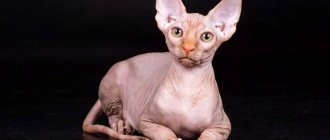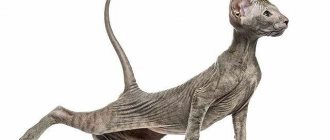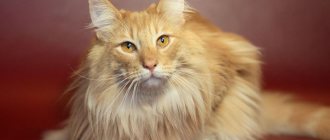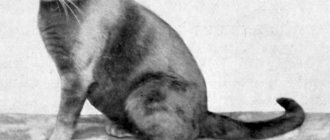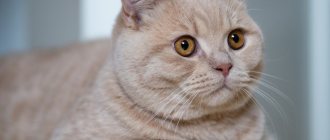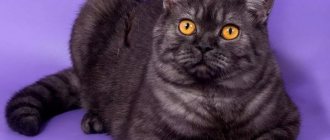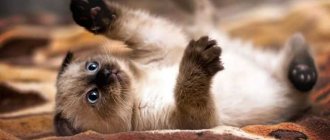When it comes to cats, what appears before your mind’s eye is a fluffy, affectionate creature with a soft and beautiful coat. This is exactly the image they answer longhaired cats
. Of course, cats with short hair or no hair at all occupy an equally honorable place in the cat world. But pets with long hair are a special caste.
The history of long-haired cat breeds goes back centuries. Nature originally endowed purring cuties with short fur. This evolutionary feature helped wild animals survive in difficult natural conditions. However, thanks to random mutations and targeted breeding work, cats with unusually beautiful long hair began to appear in the world. Moreover, the origin of each breed is individual and interesting.
Long or semi-long hair has always been a sign of nobility, royalty and chic. That is why the first beauties with unusual appearance, brought to Europe from Asia Minor in the 16th century, became the property of royalty.
To date, felinologists have recognized more than 30 breeds of cats with long fur. And the list is constantly updated with new varieties, which are gaining popularity every year. Many of the existing long-haired and semi-long-haired cat breeds were developed thanks to the persistent efforts of breeders over many years. Valuable long-haired kittens
are still under the care of nurseries and private hobbyists.
From the history of long-haired cats
Long-haired cat breeds first appeared on the European continent approximately in the mid-16th century. They were first learned about in Italy. Representatives of these breeds gained wide popularity after Cardinal Richelieu himself got himself a long-haired cat. For a long time, these animals, due to their rarity and high cost, were the privilege of only noble and wealthy people.
Until now, long-haired cats are extremely popular not only because of their attractive appearance, but also because they are rightly considered the kindest, most affectionate, tame and flexible. These pets become attached more to the owner than to the house, unlike most other cats.
Ukrainian Levkoy
These exotic creatures were bred about 10 years ago in Kyiv. The Ukrainian Levkoy is the result of crossing the Don Sphynx with Scottish Fold cats. The end result was cats with the same body contours as sphinxes, but with funny downward-curved tips of their ears.
Ukrainian Levkoy
Sometimes Levkoys can be covered with light fluff on the body - this cannot be called full-fledged wool, so this fluff is called brush (translated from English as “brush”).
How to choose the right kitten
The paradox of breeding: a long-haired baby can be born not only to Highlanders, but also to short-haired British women - in this case it will be considered as a breed defect and will cost much less. The average price of a show-class kitten is one and a half to two thousand dollars. For that kind of money (or slightly cheaper), scammers can offer you a charming furry “with documents” that will have nothing to do with the breed.
British Longhair kitten - isn't he adorable?
Study the breed standards - after all, at first glance, all fluffy kittens are similar. The British Longhair kitten is most similar to the British Shorthair kitten, which is less difficult to identify. Just imagine the baby being offered to you in a short fur coat - this will help.
British kittens, long-haired and short-haired, look like twin brothers in different coats
But it is more correct, of course, not to rely on your powers of observation, but to buy a baby from a reputable nursery and enter into an official agreement with the breeder, which can largely guarantee the breed of your baby and his hereditary health.
Health and life expectancy
In general, the breed is healthy, there are no genetically transmitted diseases. This is due to the spontaneous occurrence of Laperm and the use of strong phenotypes of cats to strengthen the breed characteristics. However, parasitic infestations (fleas, ticks, helminths, etc.) may occur. Allergic reactions rarely occur. Lapermas can suffer from infectious viral and bacterial diseases, as well as diseases caused by single-celled protozoa.
This is interesting! With proper care, pets live up to about 15 years. Some pets live longer.
Death can be caused by congenital malformations (extremely rare), serious viral diseases, parasitic infestations and associated diseases, and dangerous injuries. Improper maintenance, poor and unbalanced nutrition can also shorten life expectancy.
Cats need to be given enough attention; in adolescence, good socialization is required, otherwise pets may suffer psychologically, which is expressed in depression, which is not typical for this breed.
Features of care
Of all the cats, long-haired cats cause the most trouble for their owners. These breeds are provided with special nutrition: clean pets, while licking themselves, swallow their own fur, which, clumping into clumps in the gastrointestinal tract, can cause irreparable damage to health.
Brushing is an absolute necessity for such cats. This must be done several times a week, and during the molting period almost every day.
For complete care, you need to stock up on several types of brushes and wide-toothed combs and, of course, make sure there are no tangles.
Some long-haired cats require special grooming in the groin area: it is recommended to carefully trim the hair and undercoat there to avoid constant contamination and the formation of tangles.
In a hot climate, it will also be necessary to do without special procedures: you can help heat exchange with a neat haircut, just don’t leave the cat’s mane and lion’s tail, otherwise you never know what he might imagine.
Long-haired cats need people more than other breeds. Whether they are aloof Persians or restless Burmas, they can maintain their wealth in order only with the participation of the owner.
Somali (Somali)
The long-haired version of the Abyssinian cat was probably developed during World War II. Due to the decline in the number of Abyssinians, breeders tried to increase their numbers by introducing long-haired individuals. Only since 1960-1970. Somalis began to be identified as a separate breed.
Breed overview
Weight : 2.7-4.5 kg
Body length : 38-45.7 cm
Physical characteristics:
- strong body of medium size;
- pointed ears;
- narrow muzzle, like a Persian cat;
- color: many variations, including brown, red, blue, gray, etc.
Burmese
Although the Burmese's coat can be dyed in 6 colors and have 2 patterns, almost all representatives of the breed have blue eyes, and their four paws are “shod” in white slippers.
The history of the breed is unknown, but there are suggestions that Burmese cats were imported to France, where they were crossed with Siamese.
Breed overview
Weight : 4.5-5.4 kg
Body length : 38-45.7 cm
Physical characteristics:
- strong medium or large body;
- pointed ears;
- silky long hair;
- color: “seal”, blue, chocolate, red, cream, tortoiseshell, with dark areas or spots, like a lynx.
Character and temperament
The British Longhair is a delicate, peace-loving cat with an intelligent and easy-going disposition. She easily becomes attached to her owners and loves to spend time in the company of people. At the same time, the cat easily tolerates loneliness, does not become depressed and calmly waits for the owners to arrive on a cozy sofa.
Longhaired British cats are lenient towards children and tolerate their presence, especially if they are not too intrusive and do not bother the cats with their attention.
Due to their good-natured nature, British Longhairs get along well with their relatives and peaceful dogs. But so that a cat of this breed does not conflict with the owner’s dog, it is advisable to introduce animals at an early age.
Signs about magical pets
There are a very large number of folk signs that are associated with these creatures. They say that if you get yourself such a pet, then happiness will undoubtedly come to your home. This is especially true for white pets with black and red spots. The reason for this is the meaning of the colors they possess. We suggest considering these notations:
- white color is sincerity, harmony and cleanliness;
- black color – protection from negative and dark emotions, as well as from bad energy;
- red color means wealth and, in addition, the expulsion of painful experiences and diseases.
In Japan, these cats are generally a talisman. Therefore, they have a custom of placing a figurine of such an animal at the entrance to the house.
This is interesting! Also in Japan you can find a figurine in the form of a welcoming cat, which attracts prosperity and harmony to the home.
In Muslim countries, they believe that a tricolor cat in the house protects the house from fires and other disasters. In Great Britain, it is also customary to decorate their homes for protection with talismans that look like these animals.
There is a rather interesting sign for brides. If such a cat sneezes in front of a bride who is putting on her wedding attire, then this is an indication that the girl will be happily married. According to legend, strong family happiness and true love await her.
This is interesting! Since calico cats are quite rare animals, they are highly valued on sea ships. This animal, according to superstition, brings good luck in sea voyages.
So, we have found out that tricolor cats can not only make your home bright, harmonious, bringing you well-being. They are also distinguished by their sociability, playfulness, sincerity and wonderful character. Such pets are suitable for any family and can satisfy any owner.
Persian
Persians are famous for their long, glamorous coat, flattened muzzle, and bright eye color. These cute creatures not only have a charming appearance, but also a good character. Born to cuddle, they are extremely calm, sweet and inactive. Despite their sedentary lifestyle, which does not cause trouble to their owners, cats require careful care. If you neglect to regularly comb the fur, it quickly becomes tangled, resulting in tangles.
Breed overview
Weight : 3-5.5 kg
Body length : 35.5-45.7 cm
Physical characteristics:
- strong, medium-sized body;
- flattened muzzle;
- bright round eyes;
- long silky coat;
- color: plain, two-color, striped, calico (black-red-white), etc.
Officially recognized breeds of fluffy cats WCF – 1st and 2nd group
The Burmilla Longhair is a breed descended from the Persian and the standard Burmilla. The cats have the original chinchilla color and long hair. A kind, attentive, independent cat, loyal to all living things. Moderately sociable, preferring the “company” of toys or quiet observation of others.
The Munchkin Longhair (CFA recognized) is an unusual cat with short front legs and a habit of sitting in a marmot position. The breed has a friendly and sociable character, but can fight back if necessary.
Oriental Longhair (recognized by FIFe) is a breed with an oriental appearance and tabby color. The ancestors of the variety are standard Orientals, Siamese and domestic (aboriginal, mongrel) cats. Tailed animals are kind, faithful and too trusting, so much so that transfer to other hands can lead the animal to depression and even death “from boredom.”
The Japanese Bobtail Longhair (recognized by FIFe) is an impressively sized cat with the peculiarity of the absence of a tail (a congenital trait). The breed is people-oriented, sociable, and affectionate. The original trait is to raise one front leg while sitting.
Less common furry cat breeds recognized by the WCF
- York.
- Karelian Bobtail is long-haired.
- Cymric (FIFe recognized).
- The Kurilian Bobtail is long-haired (recognized by FIFe).
- Nibelung (CFA recognized).
- Ragamuffin.
- The La Perm Longhair (CFA recognized) is a cat with curly hair.
- Somalia (recognized by FIFe).
- Selkirk Rex Longhair (CFA Recognized).
- Chantilly Tiffany.
- The Ural Rex is long-haired.
- Highland fold (CFA recognized).
Interesting Facts
- The famous three-colored cat of Rus' is Bayun;
- The flamboyant Cardinal Richelieu kept a large number of colored favorites;
- A popular Japanese souvenir is a three-color “maneki neko” with a raised paw;
- The official animal in the US state of Maryland is the “tortoiseshell” cat;
- 99.9% with this coloration are females;
- Seals with three coat colors are infertile;
- Dilution will not work, stained coloring is a gift of nature;
- On the island of Honshu in 2007 they wanted to close the railway station. The situation was saved by a cat who was appointed boss. The cute creature greeted people, and soon the flow of passengers increased by 16%.
Features of caring for cats with long hair
All cats, especially long-haired ones, need coat care. This will not only maintain the appearance of the animal, but also prevent many health problems.
Main features of long hair care:
- the coat must be combed regularly;
- the comb must have metal teeth;
- Combing should begin with collecting fallen hairs, especially when the cat begins to shed;
- First you need to comb your pet along the hair growth, and then against it, moving from the tail.
The main thing in the combing procedure is to have patience. And this applies to both the owner and the pet. It is best to accustom long-haired kittens to care from early childhood and then there will be no problems with care in the future.
Caring for a long-haired cat
Bathing
Bathing is an important part of hygiene and care for long hair. It is necessary to accustom a kitten from an early age. Be sure to use special shampoos for animals with an acidity that is suitable for their coat and skin. It is never recommended to use human detergents, as they contain substances that can harm your pet.
Important! Long-haired cats should be bathed no more than once every 2-3 weeks, since washing removes a thin protective fat layer from the coat, which protects the skin and coat from unwanted environmental influences.
Nutritional Features
Proper nutrition is the key to the health and beauty of your pet. Long-haired cats need a special, balanced diet. The food should be varied. It must include meat, fish, vegetables, cereals, and dairy products. Cat nutrition is selected individually and the energy value of products depends on:
- body weight;
- general physiological condition of the pet;
- breed characteristics;
- activity level.
A balanced diet will allow the stomach to work properly and also ensure good coat condition.
Cat food
Long-haired cats may differ in origin, size, and character. Although they are very beautiful, they are not suitable for everyone; for example, people suffering from allergies should not have such an animal.
Laperm
Known for its striking appearance, the Laperm breed is relatively new; its origin dates back to 1982. Animals of this variety have long hair that curls tightly around the neck, ears and tail, as well as a fluffy tail in the shape of a bottle brush.
The unusual “fur coat” of representatives of the Laperm breed is the result of a genetic mutation associated with the need for the animals to develop curly hair; This feature was then propagated by breeders.
Breed overview
Weight : 2.7-5.5 kg
Body length : 30.5-45.7 cm
Physical characteristics:
- medium-sized, strong body;
- tightly curled hair around the neck, ears and tail;
- Color: Various variations, but most often tortoiseshell, calico and tabby.
Influence of genes
It is known that cats have a pair of X chromosomes (XXY), and cats have X and Y chromosomes (XY). The first of them is responsible for the appearance of black (eumelanin pigment) and red (pheomelanin pigment) in the color of the animal; white is encoded by another chromosome. Due to the presence of two X chromosomes in cats, it is possible to observe the simultaneous appearance of black and red color on a white background.
There are also cases of genetic disorders in cats when they have XXY chromosomes, as a result of which they are sterile. The gene linked to the sex of the animal, called “orange,” is found only in cats and hamsters of the Syrian breed.
One of its alleles, O, blocks the synthesis of black pigment, and orange appears in color, but the other does not block it. All specialized skin cells that produce melanin are melanocytes; if they come from a cell with the active O allele, they will appear as red hair. This gene was discovered relatively recently, in 2010, and therefore its study is still ongoing.
At the moment, scientists are faced with the fact that it is impossible to clone calico cats; their color cannot be reproduced due to the inactivation of one of the X chromosomes, reports E. Zernglow, the company's leading specialist in the field of cloning. Nature has made sure that each representative of the feline species has its own unique, individual color.
Did you know? Genetic anomalies among cats are so rare that for every 3 thousand tricolor females there is only one cat, which, moreover, cannot have offspring.
Neva Masquerade
The Neva Masquerade cat is a Siberian color-point cat. As mentioned above, Siberian standards allow many colors. But their number does not include color-point dogs (the so-called Siamese). Not all breeders considered this decision to be correct, which led to the emergence of another breed.
Nevaks (as breeders call them) look no less impressive than their relatives, and are liked by many cat lovers. However, some felinological systems do not recognize them as an independent breed, but simply added the color point color to the list of permitted Siberians.
Turkish Angora
Appearing in Turkey in the 15th century, representatives of this breed were for some time considered the only owners of both white color and blue or green eyes; also, for many years, all long-haired cats were called Angoras.
It is now generally accepted that Turkish Angora wool can come in a variety of colors and patterns.
Breed overview
Weight : 2.2-4 kg
Body length : 30.5-45.7 cm
Physical characteristics:
- long, slender and graceful body;
- pointed ears;
- long and silky coat;
- Color: Many color and pattern options including white, lilac, chocolate, calico, tabby and more.
Norwegian forest
The Norwegian Forest Cat, also known as the Wegi, has a natural origin dating back to Viking times. Similar to the Maine Coon, the Vega's past is associated with cold climates; Representatives of this breed have thick, water-resistant fur. It is recommended to bathe Norwegian cats only in exceptional cases (if the pet is very dirty or for medical reasons).
Breed overview
Weight : 5.9-9 kg
Body length : 30.5-45.7 cm
Physical characteristics:
- a large, strong body with a very thick “fur coat”;
- large soft paws;
- long fluffy tail;
- color variations: white, black, red, cream, cinnamon (red-brown, cinnamon-colored), striped.
If you think that the Himalayan cat is a little reminiscent of Persians and Siamese, you are one hundred percent right - this breed is a hybrid of Siamese and Persian. As a result of mixing two popular varieties, a magnificent animal appeared with the “fur coat” and eye color of the Siamese, as well as the long and silky hair of the Persians.
Himalayan cats are cute and playful, but do not be fooled about their carefree life together - beautiful creatures require regular care, because... their fur is prone to tangling and matting.
Breed overview
Weight : 3-5.5 kg
Body length : about 46cm
Physical characteristics:
- medium to large body size;
- wide chest, round belly;
- muscular build;
- animals often look larger than they actually are;
- color: cream, gray, blue and chocolate with dark areas.
Maine Coons
It is generally accepted that the homeland of Maine Coons is cold regions with harsh climatic conditions. This explains the presence of extremely thick and water-resistant fur in animals, large furry paws that make it easier to move on snow-covered surfaces, as well as massive fluffy tails that can be wrapped around to keep warm.
Breed overview
Weight : 4-8 kg
Body length : 91-101 cm
Physical characteristics:
- size – medium to large;
- wide chest;
- pointed ears;
- thick coat (short on the shoulders and belly);
- colors include more than 75 variations;
- eye color is predominantly green, gold or copper.
Selkirk Rex
A charming curly cat with a strong build, she is often called a bear cub or a cloud. The Selkirks have many Persian ancestors, so they are calm and friendly. But like any other breed based on random mutation, they all come from the same cat.
She was born in an American animal shelter in 1987. Do shelter employees have time to carefully examine their charges? However, one employee noticed an unusual kitten. And she reported this to the experienced felinologist D. Newman. Although several breeds of rex already existed at that time, Newman began studying the mutation. It soon became clear that this was something new. Then Newman decided to breed a new breed.
